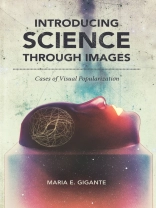An examination of how images can serve as communication tools to popularize science in the public eye
As funding for basic scientific research becomes increasingly difficult to secure, public support becomes essential. Because of its promise for captivating nonexpert publics, the practice of merging art and imagery with science has been gaining traction in the scientific community. While images have been used with greater frequency in recent years, their value is often viewed as largely superficial. To the contrary, Maria E. Gigante posits in Introducing Science through Images, the value of imagery goes far beyond mere aesthetics—visual elements are powerful communication vehicles.
The images examined in this volume, drawn from a wide range of historical periods, serve an introductory function—that is, they appear in a position of primacy relative to text and, like the introduction to a speech, have the potential to make audiences attentive and receptive to the forthcoming content. Gigante calls them ‘portal’ images and explicates their utility in science communication, both to popularize and mystify science in the public eye.
Gigante analyzes how science has been represented by various types of portal images: frontispieces, portraits of scientists, popular science magazine covers, and award-winning scientific images from Internet visualization competitions. Using theories of rhetoric and visual communication, she addresses the weak connection between scientific communities and the public and explores how visual elements can best be employed to garner public support for research.
Sobre el autor
Maria E. Gigante is an associate professor of rhetoric and writing studies in the English Department at Western Michigan University, where she has spearheaded the development of a science-writing curriculum. Her work on the visual rhetoric of science has appeared in Rhetoric Review and the Journal of Technical Writing and Communication.












